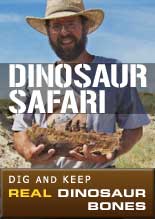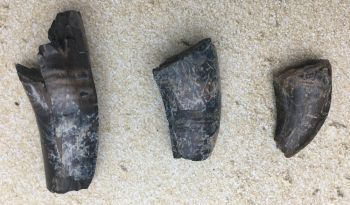
This series of 3 associated Daspletosaurus torosus teeth were found in Glacier County, Montana in October 2006. Each tooth is broken at top and bottom. Serrations are present on the front and back of each tooth. The enamel quality varies, but is generally fair, with significant root incursion on each tooth. The largest tooth is 2.17 inches. The middle tooth is 1.41 inches. The smallest tooth is 1.26 inches and includes a wear facet. These teeth were stabilized when found and have very minor crack fill for preservation only. Fossils from Daspletosaurus are uncommon and 3 teeth likely to be from the same animal are very rare. Comes in a 6x5 inch Riker Mount.
Daspletosaurus (das-PLEET-o-SAWR-əs; meaning "frightful lizard") is a genus of tyrannosaurid dinosaur that lived in western North America between about 77 and 74 million years ago, during the Late Cretaceous Period. The genus Daspletosaurus contains two species. Fossils of the earlier type species, D. torosus, have been found in Alberta, while fossils of the later second species, D. horneri, have been found only in Montana. A possible third species, also from Alberta, awaits formal identification. Daspletosaurus is closely related to the much larger and more recent tyrannosaurid Tyrannosaurus rex. Like most tyrannosaurids, Daspletosaurus was a multi-tonne bipedal predator equipped with dozens of large, sharp teeth. Daspletosaurus had the small forelimbs typical of tyrannosaurids, although they were proportionately longer than in other genera.
As an apex predator, Daspletosaurus was at the top of the food chain, probably preying on large dinosaurs like the ceratopsid Centrosaurus and the hadrosaur Hypacrosaurus. In some areas, Daspletosaurus coexisted with another tyrannosaurid, Gorgosaurus, though there is some evidence of niche differentiation between the two. While Daspletosaurus fossils are rarer than other tyrannosaurids', the available specimens allow some analysis of the biology of these animals, including social behavior, diet and life history.
While very large by the standard of modern predators, Daspletosaurus was not the largest tyrannosaurid. Adults could reach a length of 8–9 meters (26–30 ft) from snout to tail. Mass estimates have centered on 2.5 t (2.5 long tons; 2.8 short tons), but have ranged between 1.8 and 3.8 t (1.8 and 3.7 long tons; 2.0 and 4.2 short tons).
Daspletosaurus had a massive skull that could reach more than 1 meter (3 ft 3 in) in length. The bones were heavily constructed and some, including the nasal bones on top of the snout, were fused for strength. Large fenestrae (openings) in the skull reduced its weight. An adult Daspletosaurus was armed with about six dozen teeth that were very long but oval in cross section rather than blade-like. Unlike its other teeth, those in the premaxilla at the end of the upper jaw had a D-shaped cross section, an example of heterodonty always seen in tyrannosaurids. Unique skull features included the rough outer surface of the maxilla and the pronounced crests around the eyes on the lacrimal, postorbital, and jugal bones. The orbit (eye socket) was a tall oval, somewhere in between the circular shape seen in Gorgosaurus and the 'keyhole' shape of Tyrannosaurus.
Daspletosaurus shared the same body form as other tyrannosaurids, with a short, S-shaped neck supporting the massive skull. It walked on its two thick hindlimbs, which ended in four-toed feet, although the first digit (the hallux) did not contact the ground. In contrast, the forelimbs were extremely small and bore only two digits, although Daspletosaurus had the longest forelimbs in proportion to body size of any tyrannosaurid. A long, heavy tail served as a counterweight to the head and torso, with the center of gravity over the hips.
A study of D. horneri skulls suggest that unlike many depictions of tyrannosaurids, this genus and likely other tyrannosaurids did not possess lips. Comparisons of the skull of this species with modern crocodiles show the same rugose (roughly wrinkled) bone structure that indicates the presence of large flat scales as opposed to lips. As the rough texture descends almost to the tooth line, it is theorized that Daspletosaurus' teeth were not covered by lips, as there would have been no room for such soft tissue. (Wikipedia)
authentic fossil
2.17, 1.41, 1.26 Inches
Item 3433
Class: Not Specified
MORE PHOTOS:
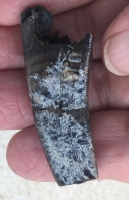
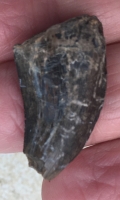
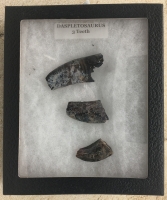
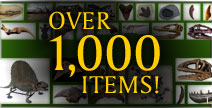
Now Over 1,000 Items!
PrehistoricStore.com offers the largest selection of replica fossils and other fossil-related products anywhere in the world!
Download a Full Catalog (3MB PDF)
OVER 260 PAGES OF REPLICAS AND MORE!
